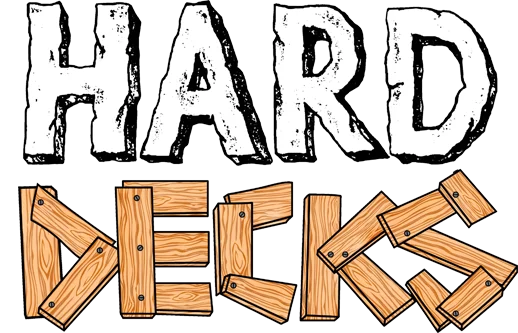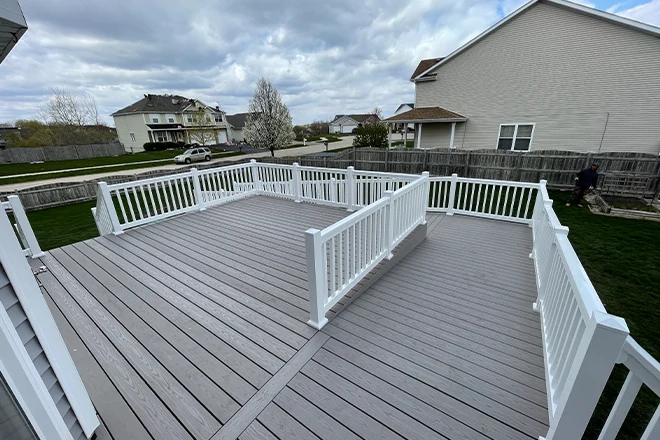
Decking Options for All Homeowners
Ever gazed out into your backyard and imagined hosting summer barbecues on a stunning new deck? Or maybe you’ve dreamed of replacing your existing deck to create a tranquil space to sip your morning coffee?
In this post, you’ll learn about the different deck material options, their pros and cons, and which ones we experts recommend.
By the end, you’ll know which material you’ll want for your new deck installation project.
What is the Best Deck Material?
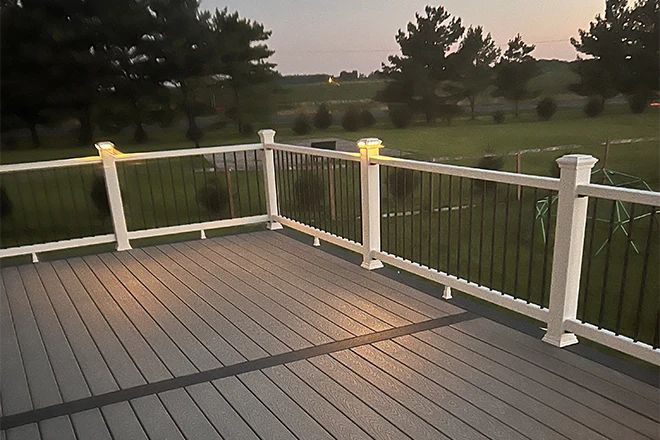
Composite decking is highly regarded for its weather resistance and minimal maintenance needs. Engineered to withstand harsh conditions, it resists moisture, UV damage, and temperature extremes, preventing rotting, warping, and fading. Composite boards last 25–30 years. Made from recycled materials, it is eco-friendly, reducing lumber demand. With a wide range of colors and wood-like textures, composite decking provides a durable, stylish solution for any outdoor space.
Contact us today about your deck project.
Wood Decking Material Options
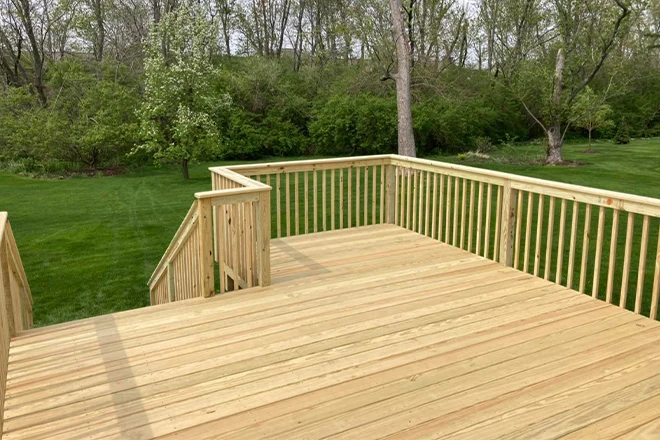
Pressure-Treated Wood Decking
Pressure-treated wood decking is a staple in deck building.
This deck material undergoes a chemical treatment process to resist rot, decay, and termites, making it a durable option for a wood deck.
It’s often made from Southern yellow pine and is the most cost-effective choice for decking material.
Pros:
- Cost-effective and widely available.
- Treated to resist rot, decay, and termites.
Cons:
- Requires annual maintenance to prevent splintering and warping.
- Chemicals used in the pressure-treating process may raise environmental and health concerns.
Cedar And Redwood Decking
Cedar and redwood offer unique aesthetic appeals with their rich colors and natural wood grain patterns.
These woods contain natural oils and tannins that make them resistant to decay, insects, and weathering, offering a more natural alternative to pressure-treated wood.
Pros:
- Natural beauty with a distinct wood grain appearance.
- Natural resistance to decay and pests without the need for chemical treatment.
Cons:
- Higher cost compared to pressure-treated wood.
- It requires regular maintenance, like staining and sealing, to maintain its color and resistance.
Tropical Hardwood Decking
Tropical or exotic hardwoods, such as ipe, mahogany, and eak, are prized for their extreme durability and natural resistance to rot, insects, and weather.
These exotic woods offer a luxurious look for any deck space but come with a higher price tag.
Pros:
- Exceptional durability and longevity.
- Rich, exotic appearance with a dense wood structure.
Cons:
- Significantly more expensive than other wood decking options.
- Difficult to install due to their density, requiring special tools.
More great information on the 5 best wood decking types.
Composite Decking

Composite decking materials are made from a blend of recycled plastic and wood fibers. It has the aesthetic appeal of wood without the maintenance headaches.
Colors, Styles, and More: One of the significant advantages of composite deck materials is the variety they offer. Whether you’re looking for a specific shade to match your home’s exterior or a particular texture, there’s likely a composite board that fits the bill.
Low Maintenance Living: Say goodbye to staining, sealing, and sanding. Composite decks are almost maintenance-free. However, like any outdoor feature, they aren’t entirely immune to the elements. In direct sunlight, they can get quite hot, and in shady areas, there’s a potential for mold growth. But, with proper care and placement, these issues can be minimized.
Cost Considerations: While composite decking can be more expensive per square foot than some other deck materials, the savings in maintenance costs over the years can make it a cost-effective choice for your new deck installation project.
Capped vs. Uncapped: When diving into the world of composite decking, you’ll come across capped and uncapped options. Capped composite decking has an added layer of durable plastic, offering more protection from the elements. Uncapped, while still sturdy, lacks this protective layer and can be more susceptible to damage over time.
Pros:
- Low maintenance deck material, requiring only occasional cleaning without the need for staining or sealing.
- Made from recycled materials, making it an environmentally friendly option.
Cons:
- Higher upfront cost compared to wood decking.
- Some homeowners may prefer the natural look and feel of real wood.
PVC Decking
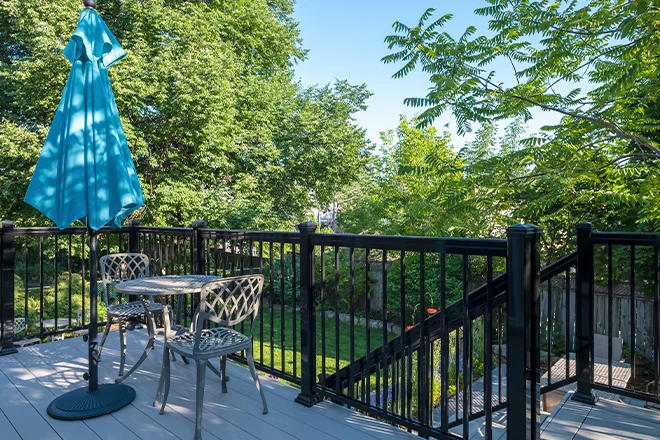
What is PVC Decking? PVC, or polyvinyl chloride, is a type of plastic used in various applications, including decking. It’s known for its resilience and almost maintenance-free nature.
Why Choose PVC? PVC decking offers a wide range of color options, ensuring you find the perfect shade for your home. Over the years, the formulations and aesthetics of PVC decks have improved significantly, making them a top choice for homeowners looking for durability and style.
Cost and Sustainability: While PVC deck materials can vary in cost, some options have less recycled content, which might be a consideration for the environmentally conscious homeowner. However, the low maintenance and long lifespan can offset the initial new deck installation investment over time.
Pros:
- Virtually maintenance-free deck material with excellent resistance to the elements.
- Available in a variety of colors and styles, including those that mimic natural wood.
Cons:
- Higher initial investment than wood decking.
- Some may find the feel and sound of PVC decking less natural than wood.
Plastic Decking
Why Plastic? Plastic decking, made from PVC or polyethylene, is a fantastic option for those who want a deck that’s resistant to warping, cracking, rot, decay, and insects. Plus, there’s no need for sanding, staining, or sealing after your new deck installation.
Heat and Appearance: One thing to note is that the surface of this deck material can get hot in direct sunlight. Over time, some plastic decks may develop a chalky coating. But with the right care and high-quality boards, this can be minimized.
Easy Installation: For those looking to build a deck themselves, plastic decking offers easy access and installation, with many boards designed for quick laying and fastening.
Pros:
- Requires little to no maintenance over its lifespan.
- Will not rot, warp, or splinter over time.
Cons:
- This deck material can feel less natural underfoot compared to wood or composite materials.
- Limited aesthetic options compared to wood and composite decking.
Aluminum Decking
Strength and Resistance: Aluminum decking is not just about sleek looks; it’s also about strength. It’s fire-resistant, making it an excellent choice for areas prone to wildfires. For homes near water bodies, aluminum’s resistance to moisture is a significant plus.
Cost Considerations: While the initial deck cost for aluminum can range from $15 to $25 per square foot, its longevity and minimal maintenance needs can make this deck material a cost-effective choice over time.
Aesthetic and Features: Aluminum decks offer a modern look, perfect for contemporary homes. They come with features like interlocking boards, which help in water management, especially if you’re planning a patio or some furniture below the deck.
Pros:
- Superior durability and lifespan, virtually indestructible.
- Lightweight and cool to the touch, it is ideal for areas with high foot traffic.
Cons:
- The most expensive option among decking materials.
- The metallic look and feel might not suit all aesthetic preferences.
Factors to Consider When Choosing Materials for Decks
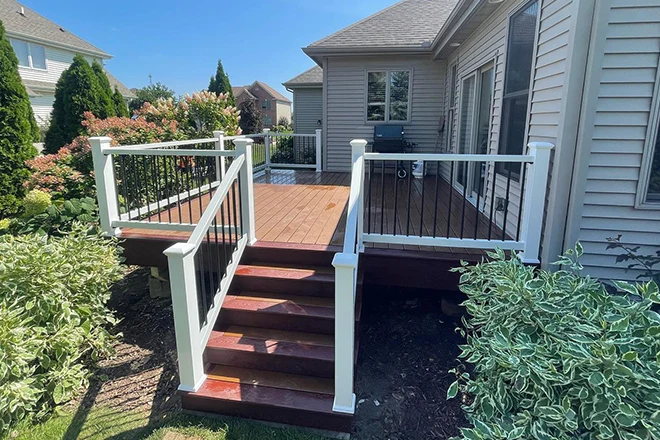
Selecting the right decking material for your home involves more than just picking the most visually appealing option or the one that fits within your budget. Several critical factors play into the decision, ensuring your deck not only looks beautiful but also stands up to the local climate, meets your usage needs, and complements your home’s aesthetic. Here’s what to keep in mind as you narrow down your deck material choices.
Climate and Weather Resistance
Climates with its hot summers and cold, snowy winters demand decking materials that can withstand a wide range of weather conditions.
For instance, pressure-treated wood and tropical hardwoods are known for their natural durability against moisture and temperature changes, making them suitable for this region.
Composite decking and PVC materials offer excellent resistance to weathering without the need for regular maintenance, a boon for those looking to enjoy their deck rather than upkeep it.
Usage and Traffic
Consider how you plan to use your deck.
Is it for quiet evenings with the family in your Logan Avenue neighborhood, or do you anticipate hosting large gatherings?
High foot traffic demands a durable deck material like composite or aluminum, which can withstand the wear and tear of numerous guests.
Wood decks, while beautiful, may require more maintenance to keep them looking pristine under heavy use.
Personal Style and Home Aesthetics
Your deck should be a continuation of your home’s style, with the deck material seamlessly blending with the architecture and outdoor environment.
Wood decking offers timeless appeal and natural beauty, with options like cedar and redwood providing distinct, rich colors.
Composite and PVC decking materials come in a wide range of colors and textures, enabling homeowners to achieve a particular look or match their home’s exterior.
Aluminum decking, with its sleek, modern appearance, might be the perfect match for contemporary home designs.
Long-term Investment and Value
When considering decking materials, think beyond the initial cost to the long-term investment and value added to your home.
While pressure-treated and other woods might be the most budget-friendly option upfront, its maintenance costs can add up.
Composite and PVC decks, despite their higher initial price point, offer significant savings over time due to their minimal maintenance needs.
Additionally, a well-chosen deck material can enhance your property’s resale value, making it a wise investment in your home’s future.
Deck Material Recommendations From Hard Decks
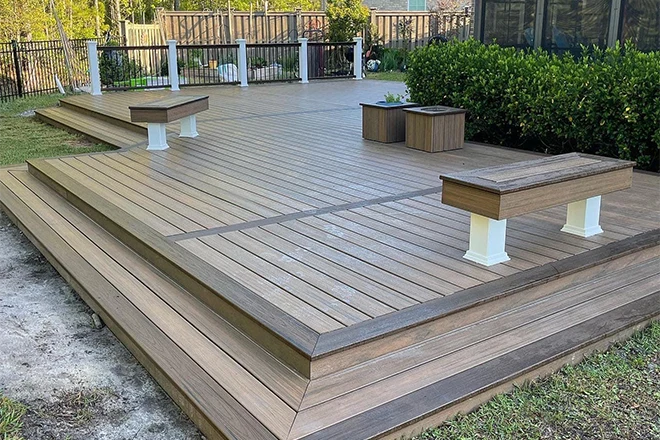
When it comes to building a deck, the choice of materials is crucial. Hard Decks recommends a range of materials depending on your budget and preferences. Here’s a breakdown of the materials recommended by us for different levels of decking projects:
Pressure-Treated Decking
For those on a tight budget looking for a simple and functional deck, pressure-treated decking and railings is an excellent choice.
This option is ideal for homeowners who want a basic deck without the frills.
Economy Level Composites Deck Boards
If you’re looking for a step up from pressure-treated wood, we recommend economy-level composite deck boards such as Trex Enhance, Deckorators Venture, Timbertech Prime, or Timbertech Premier.
This option is perfect for homeowners who want a stylish deck without breaking the bank.
Standard Composites Deck Boards
For those seeking a balance between style and durability, standard composite deck boards are recommended. Options like Trex Select, Deckorators Vista or Vault, and Timbertech Legacy or Reserve are excellent choices.
This option is ideal for homeowners who are willing to invest a bit more for a higher-quality deck.
Premium Composites/PVC Deck Boards
For the ultimate in luxury and durability, we recommend premium composite or PVC deck boards such as Trex Transcend, Deckorators Voyage, or AZEK Vintage.
This option is for those who desire the best of the best and are willing to invest in a deck that will be the envy of the neighborhood.
Deck Railing Materials
Aluminum: Sleek, modern, and long-lasting, aluminum railings are a top choice for those looking for minimal maintenance and maximum style.
Cable: For those seeking a more contemporary look, cable railings offer a clean, unobstructed view, making them perfect for decks with a view.
Composite: Matching your composite deck with composite railings? A great choice! They offer the same low-maintenance benefits and come in a variety of styles.
Making the Final Decision: How to Choose the Best Deck Building Material Options
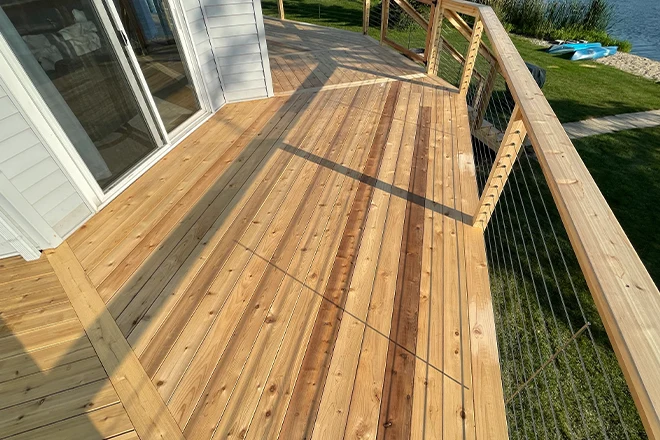
Consider Your Lifestyle and Needs
Foot Traffic: How often will your deck be used? If you’re someone who loves hosting BBQs and parties or just enjoys spending time outdoors, you’ll want a material that can withstand heavy foot traffic.
Exposure: Is your deck constantly exposed to the sun, or is it shaded? Some deck materials, like certain woods, can stain or fade when exposed to direct sunlight.
Deck Size and Budget: The size of your deck and your new deck installation project budget will play a significant role in your decision. Larger decks will require more materials, and certain decking options can be pricier than others.
Maintenance: How much time are you willing to invest in maintaining your deck? While some deck materials are almost maintenance-free, others might require regular staining, sealing, or other care.
Think About the Extras
Add-Ons: Are you considering add-ons like stairs, railings, or other finishing touches? These can influence the overall deck installation cost and the type of material you choose.
Fasteners, Screws, and Installation: Some deck boards might require specific screws or fasteners. It’s essential to ensure that the material you choose aligns with the new deck installation method you’re considering.
Resistance: In areas prone to moisture or mildew, you’ll want to opt for deck materials that offer resistance to these elements.
Visualize and Test
Before making a final decision, it’s a good idea to see samples in person. Visit local suppliers or showrooms to get a feel for the materials. If possible, walk on them to see how they feel underfoot.
Consult With Professionals
If you’re still unsure, consider consulting with deck-building professionals. They can provide insights based on your specific decking needs and the nuances of the local climate and lifestyle.
FAQs About Deck Materials
What is the cheapest decking material?
Pressure-treated wood is the most affordable decking material, costing $25 per square foot for materials. It’s widely available, durable when maintained, and can be painted or stained for different finishes.
What is the best material to use for decks?
Composite wood decking is the best material for decks due to its durability, low maintenance, and long lifespan of 25–30 years. It resists rot, insects, and warping and doesn’t require sealing or staining.
What is the best low-maintenance decking material?
Fiber cement decking is an excellent low-maintenance option. Resistant to rot, pests, and fire, it mimics the look of wood while requiring only periodic cleaning. It competes with composite decking, offering better fire and weather resistance for certain climates.
Take the Next Step Towards Your Dream Deck With Hard Decks
Ready to transform your backyard into the ultimate outdoor living space? Don’t let another summer pass by without the deck you’ve always wanted.
With Hard Decks, you can rest assured that you’re getting the best in quality and service. We’re the best deck builders in Illinois.
So why wait? Fill out our contact form today or give us a call, and let’s make your decking dreams a reality!
